Music for the Ceremony
There are several parts of the wedding ceremony that will require music. Generally, these are: the Prelude (the time when guests are arriving and being seated), the Bridal Procession (the bride’s grand entrance and walk down the aisle with her father), the Ceremony (quiet times during the ceremony that require musical interludes), the Recessional (as the bride and groom leave the church together) and the Postlude (as the guests are filing out on their way to the reception).
The Prelude sets the tone of your wedding: will it be elegant, joyful, religious or solemn? There are many classical and contemporary pieces to choose from. Of course, everyone has heard the beautiful strains of the Bridal Chorus from Wagner’s Lohengrin (Here Comes the Bride) as it accompanies the lovely bride being escorted down the aisle by her father. Another traditional song used for the bride’s processional is Canon in D by Pachelbel, as are Bach’s Ave Maria, Vivaldi’s Spring and Beethoven’s Fur Elise.
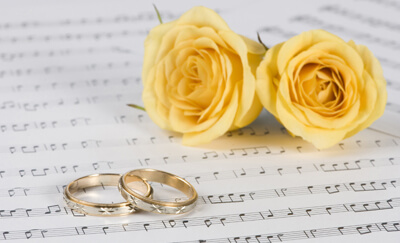
Your choice of music will set the tone of your wedding: will it be elegant, joyful, religious or solemn?
There are also times within the ceremony when a little quiet background music is appropriate, such as during the lighting of a unity candle or giving of the Sign of Peace. Some good selections for this are Schubert’s Ave Maria, Bach’s Wachet Auf, and Ungar’s Ashokan Farewell as well as DeBussy’s Clair de Lune.
As far as wedding recessionals go, the three most popular are Mendelssohn’s Wedding March, Bach’s Jesu, Joy of Man’s Desiring and Beethoven’s Ode to Joy.
Do you have a favorite piece of music for weddings?
Non-traditional Choices
As mentioned, the music you select for your special day will help to set the tone and provide ambiance for the entire event, so you needn’t be constrained by classical or modern traditional choices.
If your wedding has a theme (Celtic, medieval, beach, island, Italian) you should have music that represents that motif throughout the entire event. Remember that you must choose music for the bridal processional, the ceremony itself, the recessional and the reception. This allows you to broaden your musical horizons to include a steel drum band, a minstrel, or a group of folk singers.
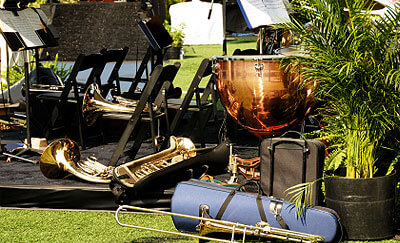
Remember that you must choose music for the bridal processional, the ceremony, the recessional & the reception.
Don’t forget to include dances or music that might be customary for the culture or theme you are following. For example, at traditional Scottish weddings there is often a dance after the ceremony, called a ceilidh. This involves traditional Scottish music and includes dances such as a "Strip the Willow", "Dashing White Sergeant", and "The Gay Gordons". “Mairi’s Wedding”, a song written by Johnny Bannerman in 1934 using a traditional Scots tune is popular in weddings with a Scottish theme.
Another choice for a Celtic theme is to use traditional Irish music such as slow airs and hymns for the ceremony followed by upbeat jigs and reels at the reception.
Been to a theme wedding lately?
Music at the Reception
Now you will need to decide whether you be using a live band, a string quartet, a DJ or something as simple as your iPod.
Consider the space you have for the reception. A live band requires more room than a string quartet, and a DJ requires very little space at all and has quite a bit more in his repertoire. If you are hiring a live band, make sure that you have seen them perform and get a list of the songs they are able to play. Same thing with a string quartet. If you are hiring a DJ, make sure they have a charismatic personality and are in tune with your musical likes and dislikes. Nothing can put a damper on a celebration faster than a DJ with no personality or one who wants to play the greatest hits of the 80s in an endless loop.
Once you’ve chosen your performers or players, you need to think about musical selections for the first dance, father/daughter dance, mother/son dance, and high points like bouquet/garter toss and the last dance of the evening.
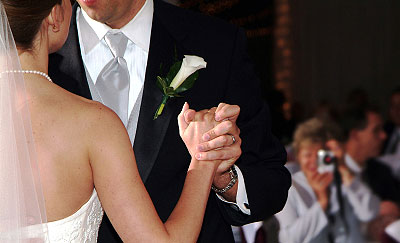
For the 'first dance' it is best to choose a song that you are both very comfortable dancing to, practice lots!
When choosing music for your first dance, think about the lyrics of the song and whether the two of you will be able to dance to it well. You might even practice dancing to a few songs to determine which one best fits your style. Be wary of current or trendy songs-of-the-moment. If you are choosing music to fit a theme, make sure you are able to perform a dance in accordance with the music!
Let the Music Move You
There is no better way to get your guests in the swing of things than for the bride and groom to lead the way. Don’t just dance the first dance -- enjoy the night on the dance floor -- after all, it’s your party!
Did You Know?
Music played a huge role in Celtic weddings. One of the most often used instruments was a bagpipe. A piper often led the wedding procession, played during the communion, and also accompanied the recessional. A ceilidh band was commonly used at wedding receptions and is still popular today.

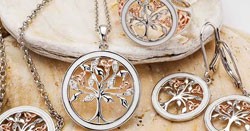
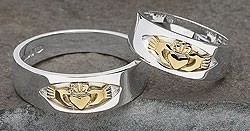
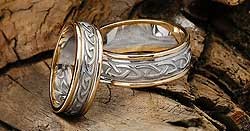
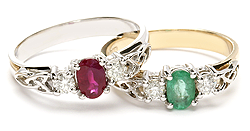
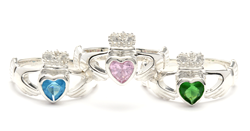
 Sapphire and Diamond Ring
Sapphire and Diamond Ring 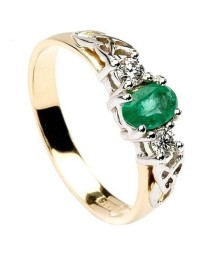 Emerald and Diamond Ring
Emerald and Diamond Ring 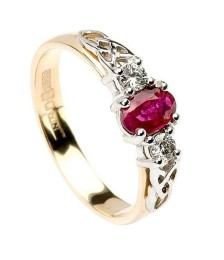 Ruby Engagement Ring
Ruby Engagement Ring 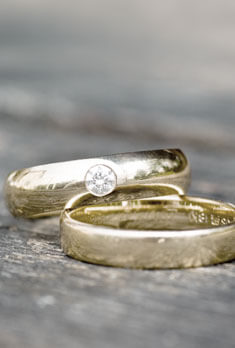

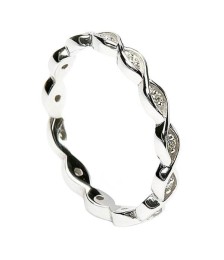 Infinity Knot Diamond Ring
Infinity Knot Diamond Ring 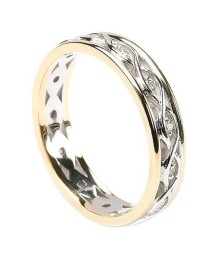 Infinity Ring with Trim
Infinity Ring with Trim 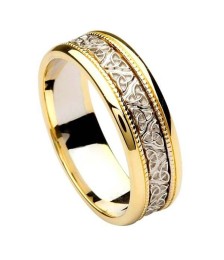 Men's Trinity Knot Band
Men's Trinity Knot Band